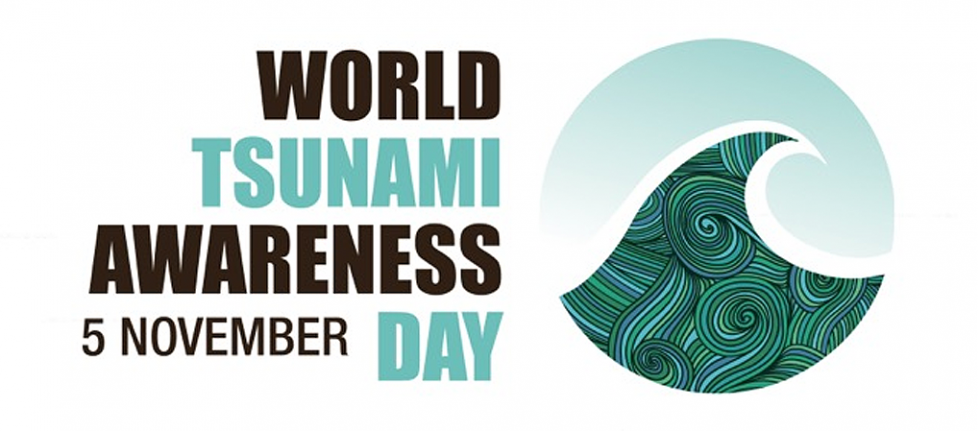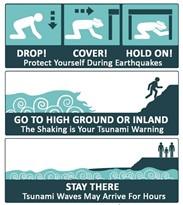Raising Tsunami Awareness
Friday, November 5, is World Tsunami Awareness Day. Though
tsunamis are less likely to occur than wildfires in California,
they are still extremely deadly and 13 of our 58 Counties border
the coast – meaning one-fifth of our Counties, maybe more, could
be severely impacted if a tsunami occurred. 
Did you know, the word “tsunami” comprises the Japanese words “tsu” (meaning harbour) and “nami” (meaning wave)? Tsunamis are a series of waves created by an underwater disturbance, usually associated with earthquakes occurring below or near the ocean. These rare events can be extremely deadly—in the past 100 years, 58 of them have claimed more than 260,000 lives, or an average of 4,600 per disaster, surpassing any other natural hazard.
In 2015, the UN General Assembly designated November 5 as World Tsunami Awareness Day. Ambassador Kimihiro Ishikane, Permanent Representative of Japan to the UN, described the significance of the date during last year’s observation.
Ambassador Ishikane explained, “this recent experience reminds us of the importance of raising public awareness of the risk posed by tsunami. It also teaches us the significance of international cooperation to mitigate its impact in all phases of prevention, preparedness, response, and recovery.”
Ambassador Ishikane continued that Japan will continue to share
its expertise and lessons learned while continuing to
work closely with countries in need to implement the
Sendai Framework for Disaster Risk Reduction. The framework
is equally applicable to Tsunamis as any natural disaster and
calls for education, preparation, cooperation, and global
partnerships for disaster recovery, risk reduction, and
mitigation. Watch a video about the framework and efforts to
promote tsunami awareness
here. More on the history of World Tsunami Awareness Day is
available in
this recent column in the Eureka
Times-Standard. 
In 2018, Rikuzentakata Mayor Futoshi Toba, Chief Executive Office of Rikuzentakata Agency Co. Kiyoshi Murakami, then-Crescent City Mayor Blake Inscore, and Del Norte County Supervisor Chris Howard were invited to attend the United Nation’s tsunami commemoration and make an official speech on the recovery from devastation and the lessons learned in Rikuzentakata following the 2011 tsunami disaster. Murakami credits the County/Sister City relationship for further dissemination of both tsunami awareness and disaster risk reduction worldwide.
There are many allies and resources available to help educate and prepare counties, communities, and citizens about tsunamis and their impact. As Ambassador Ishikane mentioned, public awareness is key in mitigating the impacts of a tsunami.
In coordination with the Governor’s Office of Emergency
Services/Cal OES and the California Geological Survey, California
traditionally celebrates Tsunami Preparedness Week in March,
aligned with the National Tsunami Hazard Mitigation
Program. 
Working in partnership with California Geological Survey’s Tsunami Web app, the California Department of Conservation has updated 13 of the state’s 20 coastal county tsunami maps. The latest maps cover Orange, Santa Barbara, San Luis Obispo, San Francisco, Santa Clara, and Contra Costa Counties. These developed detailed maps allow residents to prepare for safe evacuation in worst-case scenarios. Distinct colors and the advice to move from yellow (tsunami flooding zone) to green (safe areas) with clearly marked street names and local landmarks help make the maps relevant and understandable for residents.
Another statewide tsunami preparedness effort is a partnership between the Redwood Coast Tsunami Work Group and the California Seismic Safety Commission to develop K-12 tsunami safety curriculum tied to the book The Extraordinary Voyage of Kamome, a Tsunami Boat Comes Home, which is now available in eight languages, all available for download at https://digitalcommons.humboldt.edu/monographs/1/, and most available in print form through Amazon.
An animated version of the story is available in English,
Japanese, and Spanish on the Kamome and RCTWG websites. Some of
the lessons are aligned with the Great California ShakeOut in
October, and others can be used as stand-alone lessons about
culture, folktales, and other stories of children who have
alerted locals to tsunami dangers around the globe. Several
thousand educators have already accessed the Kamome-inspired
curriculum (available in English, only) here.
Other educational efforts inspired by and developed following the Kamome discovery include the development of regional tsunami safety brochures, a preparedness triad available in 13 different languages and a magazine called Living on Shaky Ground.
As World Tsunami Awareness Day is observed on Friday, we invite you to review these resources, maps, and curriculum. They are one more way that the Sister City/County relationship between Rikuzentakata and Crescent City/Del Norte County continues to positively impact safety and awareness both locally and globally.











































